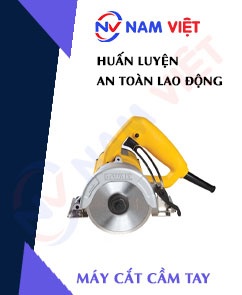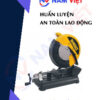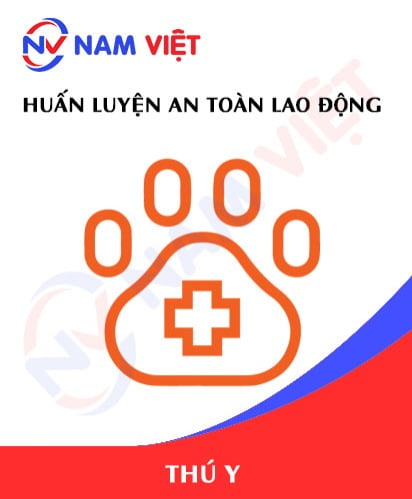Occupational Safety Training for Operating a Handheld Cutting Machine
99,000 ₫
Note: The above price is calculated for one person and may vary depending on the number of trainees participating in the course and market fluctuations. For more accurate pricing support, please refer to the price list or contact our consultants directly.
Occupational safety is an important issue when operating a handheld cutter and needs to be addressed promptly to ensure the health and safety of workers and enhance the reputation of businesses here. The Occupational Safety Training course is one of the effective solutions to raise awareness on preventing workplace accidents for workers when operating a handheld cutter.
Table of Contents
Toggle1. Overview of Handheld Cutters
a. What is a Handheld Cutter?
A handheld cutter is a portable device designed to cut, divide, or sever various materials. These handheld cutters can be used in a wide range of contexts, from construction and mechanical work to crafts and even gardening. They are typically designed for convenience, ease of use, and high safety.
There are many types of handheld cutters, each designed for specific materials. For example:
- Paper cutter: Used to cut paper, cardboard, and related materials in offices and craft activities.
- Metal cutter: Used to cut metal and is an essential tool in construction and metalworking industries.
- Wood cutter: Used to cut wood and is important in construction and woodworking projects.
- Fabric cutter: Used in the fashion and garment industry to cut fabrics.
- Grass cutter: Usually handheld or shoulder-mounted, used for cutting grass in gardening and landscape maintenance.
- Pipe cutter: Used to cut metal or plastic pipes in plumbing or gas piping work.

b. Operating Principles of Handheld Cutters
The operating principle of a handheld cutter can vary depending on the type of cutter and its intended use. Here are some common principles:
- Blade or cutting edge: Most handheld cutters use a sharp blade or cutting edge to slice materials. The blade can be a knife or saw blade depending on the material being cut. The basic principle is moving the blade through the material to apply cutting force. The blade can be powered manually or by a motor.
- Motor or power source: Handheld cutters often use a motor or other energy source to generate cutting force. This can include electric motors, gasoline engines, or pneumatic power, depending on the cutter type. The motor or power source drives the blade through the material.
- Controls and guidance: The operator uses controls, levers, or handles to guide the cutter and control the cutting process. Detailed instructions on proper use and safety are usually provided in the device manual.
- Safety features: Handheld cutters typically include protective measures to ensure user safety. These may include safety switches, locks, or warning designs to prevent injuries during use.

c. Industries Using Handheld Cutters
Handheld cutters are used across many industries to cut, divide, or shape various materials. Key industries include:
- Construction industry: Metal and wood cutters are often used in construction to cut and process building materials such as steel, wood, and formwork.
- Metalworking industry: Metalworking uses metal cutters to cut and shape metal sheets and pipes.
- Woodworking industry: Wood cutters are used to process wood into products such as panels, plywood, and furniture.
- Garment industry: Fabric cutters are used to cut layers of fabric into clothing parts or other textile products.
- Food industry: Food cutters are used to slice and portion foods like meat, fish, vegetables, or bread in food production and catering.
- Electronics industry: Handheld cutters are used to cut and process electronic components like cables, wires, and small parts.
- Automation industry: Handheld cutters are used in automation processes to cut and handle materials during production.
- Mechanical and power transmission industry: Handheld cutters are used to cut pipes, bearings, and machinery parts in this sector.
2. Overview of Occupational Safety Training for Handheld Cutter Operation
a. What is Occupational Safety Training?
- Occupational safety training for operating handheld cutters consists of sessions that raise awareness on preventing workplace accidents. Workers directly using handheld cutters belong to Group 3.
- This training helps workers identify hazards and minimize risks, reducing the chance of workplace accidents during operation.
REGISTER FOR OCCUPATIONAL SAFETY TRAINING
b. Training Duration
Initial safety training:
- Total training duration is at least 24 hours, including testing.
- 8 hours of theoretical study on safety policies and labor hygiene laws.
- 8 hours of theoretical study on basic occupational safety and hygiene knowledge.
- 4 hours of theoretical study on specialized training content.
- 2 hours of practical training on specialized content.
- 2 hours of theoretical test at the end of the course.
The training center may split the schedule into multiple sessions depending on worker availability, typically 6 sessions over 3 days if continuous attendance is possible.
Periodic safety training:
- Before the occupational safety card expires, workers must attend periodic safety training, with a duration of at least 50% of the initial training duration.
Explanation: The total periodic training duration is at least 12 hours, including testing. After completing the training and passing the test, the worker’s safety card will be renewed.
c. Training Content
| No. | TRAINING CONTENT | TRAINING DURATION (HOURS) | |||
| Total | Including | ||||
| Theory | Practical | Test | |||
| I | Safety policies and labor hygiene regulations | 8 | 8 | 0 | 0 |
| 1 | Overview of occupational safety legal documents. | 6 | 6 | ||
| 2 | Standards and technical regulations on occupational safety and hygiene. | 1 | 1 | ||
| 3 | Specific regulations by state authorities regarding safety and hygiene when constructing, expanding, or renovating facilities, using and maintaining machines, equipment, materials, or substances requiring strict safety standards. | 1 | 1 | ||
| II | Basic occupational safety knowledge | 8 | 8 | 0 | 0 |
| 1 | Basic knowledge of workplace hazards and harmful factors. | 4 | 4 | ||
| 2 | Methods to improve working conditions. | 1 | 1 | ||
| 3 | Safety culture in production and business. | 1 | 1 | ||
| 4 | Rights and obligations of employers and workers; safety policies; functions of safety officers. | 1 | 1 | ||
| 5 | Safety rules, signage, use of personal protective equipment; first aid and occupational disease prevention skills. | 1 | 1 | ||
| III | Specialized training content | 6 | 4 | 2 | 0 |
| Comprehensive knowledge of machines, equipment, and hazardous substances; risk analysis, safety management, and safe operating procedures for machines and substances requiring strict safety standards. | 6 | 4 | 2 | ||
| IV | Final safety test | 2 | 2 | 0 | 0 |
| Total | 24 | 22 | 2 | ||
See more training content for all 6 groups
d. Occupational Safety Card
After completing the occupational safety training and passing the test, workers will be issued a safety card (commonly called the Group 3 occupational safety certificate).
The Group 3 card includes personal information such as name, date of birth, job, and work environment, along with training duration, official stamp, and signature confirming course completion.
According to Clause 2 of Article 24, Decree 44/2016/ND-CP, there are two cases:
- If the employer and worker have a labor contract, the employer must sign and stamp the safety card after the worker completes training and passes the test.
- If the worker is freelance or temporary, without a labor contract, the training unit must sign and stamp the safety card after the worker completes training and passes the test.

3. Hazards When Operating Handheld Cutting Machines
Operating handheld cutting machines can pose many hazards, and failure to follow safety rules can lead to serious accidents. Here are some common hazards when using handheld cutting machines and ways to avoid them:
- Injuries from cutting blades: The cutting blade can cause injuries if not used carefully or if it is worn or damaged. To prevent this hazard, always ensure the blade is sharp and in good condition. Use safety measures such as gloves and protective goggles.
- Electrical hazards: If the handheld cutting machine is electric, there is a risk of electric shock if the machine is not insulated or used in wet conditions. Always follow the manufacturer’s instructions for using electrical equipment.
- High temperatures and heat rays: Handheld cutting machines operate at high temperatures and can generate heat rays. Carelessness may lead to fire, explosions, or burns. Always follow instructions and operate in a safe environment.
- Noise and vibration: Handheld cutting machines often generate noise and vibration, which can harm users if excessive or prolonged. Use ear protection and appropriate body protection to ensure safety.
- Fire and explosion: If the machine uses fuel such as gasoline or oil, there is a risk of fire or explosion if not used properly or in hazardous environments. Always check fuel levels, maintain the machine properly, and operate in a safe environment.
- Loss of control: Using the machine without proper handling can lead to loss of control and accidents. Always follow the manufacturer’s instructions and focus on the work process.
- Incorrect operation and overloading: Using the machine at the wrong speed or pressure can increase the risk of blade breakage or machine damage. Follow the manufacturer’s instructions and use the machine correctly.

4. Measures to Prevent Work Accidents When Using Handheld Cutting Machines
To prevent work accidents when operating handheld cutting machines, specific safety measures must be implemented. Here are the important steps you should take:
- Training: Ensure all users of handheld cutting machines are trained in proper equipment use, safety rules, and emergency measures. They should fully understand the risks and how to avoid them.
- Equipment inspection: Before use, inspect the machine to ensure it functions correctly, the blade is sharp, and there are no technical faults.
- Use protective gear: Always ensure users wear personal protective equipment, including safety goggles, face shields, ear protection, gloves, and appropriate protective clothing.
- Maintain safe distance: Keep a safe distance between hands and cutting parts. Avoid placing hands near the blade while the machine is operating.
- Use in a safe environment: Ensure the machine is used in a safe environment without fire hazards or unauthorized access.
- Do not work alone: When using handheld cutting machines, work in pairs or have someone nearby to assist in emergencies.
- Machine maintenance: Perform regular maintenance on the machine, including checking blades, lubrication, and other parts. Ensure the machine is always in good working condition.
- Follow manufacturer instructions: Always follow the manufacturer’s usage and safety instructions, including handling, storage, and operation.
- Immediate inspection and repair: If any malfunction or damage is detected, stop using the machine immediately and repair it or seek professional assistance.
- Periodic inspection of handheld cutting machines to detect safety issues early, such as wear or mechanical failure, thus reducing the risk of workplace accidents.
5. Benefits of Occupational Safety Training
An Toàn Nam Việt provides your business with the following benefits after completing occupational safety training courses as regulated by Decree 44/2016/ND-CP on labor safety and hygiene:
- Workers can identify potential work hazards and take preventive measures to avoid accidents.
- Your company can implement risk prevention measures in production, operation, and maintenance processes.
- Reduce costs associated with safety risks in the workplace.
- Uninterrupted production increases productivity and product quality.
- Ensure compliance with labor safety laws, avoiding legal risks.
- Enhance credibility and professionalism, boosting your company’s brand value.
Nam Viet’s training courses help individuals prevent external hazards that may lead to injuries or even death.
REGISTER FOR OCCUPATIONAL SAFETY TRAINING
6. Customer Feedback After Completing Training
An Toàn Nam Việt has years of experience supporting many businesses in Vietnam, especially in the southern provinces. This responsibility is highly valued, which is why Nam Viet’s occupational safety training is increasingly professional. Our growth is fueled by positive feedback and suggestions from our partners. Below are some testimonials from companies we have served.
See more customer interviews after using the service from An Toàn Nam Việt
7. An Toàn Nam Việt’s Occupational Safety Training Capabilities
An Toàn Nam Việt is a reputable and high-quality occupational safety training center in Vietnam, conducting training continuously at factories, workshops, or construction sites across all 63 provinces.
REGISTER FOR OCCUPATIONAL SAFETY TRAINING
Occupational Safety Training License
- An Toàn Nam Việt has been inspected and certified by the Department of Safety under the Ministry of Labor – Invalids and Social Affairs, confirming our qualifications for occupational safety training.

Training Materials
- All training materials are reviewed to ensure knowledge accuracy and practical effectiveness before being used in courses.
- Instructors’ teaching methods follow An Toàn Nam Việt standards, developed by safety experts to maximize learners’ knowledge absorption.
Facilities
- Controlling classroom factors increases teaching efficiency and knowledge retention.
- Our training facilities include spacious, well-lit classrooms with proper training equipment.
8. Nationwide Reputable Occupational Safety Training Center
At An Toàn Nam Việt, we prioritize occupational safety training. Educating workers to protect themselves contributes to national development.
We carefully prepare every detail of training, from tools, equipment, and materials to audio and lighting.
Our instructors are experts with years of experience and research on hazard identification across all industries. Lectures are practical, engaging, and compliant with Decree 44/2016/NĐ-CP, helping workers apply safety measures effectively in their work.
Our training center offers:
- Competitive training costs without compromising quality.
- Flexible training schedules to match company production.
- Quick certification procedures following legal regulations.
- Experienced trainers.
- Well-controlled classrooms for effective learning.
- Tailored lectures for enterprise labor safety.
- Dedicated, professional service ensuring fast and accurate support.

9. Additional Occupational Safety Training Materials
- Occupational safety materials for handheld cutting machines
- Complete occupational safety training materials
- Occupational safety training test sets
- Safety quiz for handheld cutting machines
- Training slides for handheld cutting machines
10. Occupational Safety Training Activities
1 review for Occupational Safety Training for Operating a Handheld Cutting Machine
No comments yet















phanminhhang341
Giảng viên dạy rất sinh động dễ hiểu!